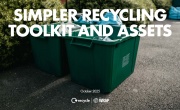Marine litter costs $13 billion a year

An albatross chick that has died after ingesting plastic. By Duncan Wright (USFWS) [Public domain], via Wikimedia Commons
Waste plastic that has entered marine ecosystems costs $13 billion (£7.7 billion) in damage annually according to two United Nations Environment Programme (UNEP) reports.
The figure comes from the UNEP Year Book 2014 and Valuing Plastic, a UNEP-supported report produced by Plastic Disclosure Project (PDP) and Trucost Business, which were released during the inaugural meeting of the United Nations Environment Assembly (UNEA).
The assembly, which is the highest-level UN body ever convened on the environment, is currently taking place at the UNEP headquarters in Nairobi, Kenya over the course of five days (23 to 27 June).
Both reports highlight that a large and unquantifiable amount of plastic waste enters the ocean with devastating effects due to littering, poorly managed landfills, tourist activities and fisheries.
Plastic waste that floats on the surface can travel large distances on ocean currents, polluting shorelines or accumulating in massive mid-ocean gyres potentially causing problems including: mortality or illness when ingested by sea creatures such as turtles; entanglement of animals such as dolphins and whales; and damage to critical habitats such as coral reefs.
In addition, the reports highlight concerns about the threat of chemical contamination, the spread of invasive species through plastic fragments and potential economic damage to the fishing and tourism industries in many countries.
A ‘conservative’ estimate
Valuing Plastic suggests that the yearly estimate of $13 billion in financial damage is ‘most likely a significant underestimate’, noting that marine pollution contributes the most to the total natural capital cost of plastic use in the consumer goods sector each year.
It is hoped that highlighting the negative financial impacts of marine litter will cause the consumer goods sector to reconsider its role in reducing plastic waste.
Indeed, Valuing Plastic, which looks at the end-of-life management for all plastics, not just those that end up in marine ecosystems, suggests that consumer goods companies could save $4 billion (£2.35 billion) per year on good plastic waste management.
UNEP Executive Director Achim Steiner said: “Plastics undoubtedly play a crucial role in modern life, but the environmental impacts of the way we use them cannot be ignored.
“These reports show that reducing, recycling and redesigning products that use plastics can bring multiple green economy benefits – from reducing economic damage to marine ecosystems and the tourism and fisheries industries, vital for many developing countries, to bringing savings and opportunities for innovation to companies while reducing reputational risks.”
Richard Mattison, Trucost Chief Executive, added: “Natural capital valuation has the power to help organizsations understand their environmental impacts, including pollution of the ocean.
“By putting a financial value on impacts such as plastic waste, companies can further integrate effective environmental management into mainstream businesses. By highlighting the savings from reuse and recycling, it builds a business case for proactive sustainability improvements.”
Microplastics
The UNEP Year Book 2014 highlights growing concern over the particular effects of microplastics as they pollute marine ecosystems.
Microplastics are particles up to five millimetres (mm) in diameter that are either manufactured or created when plastic waste breaks down.
The report shows that the increasing use of microplastics in consumer goods, such as microbeads in toothpaste, gels and facial cleansers, has resulted in higher pollution in rivers, lakes and oceans as the sewage process tends to be unable to filter them out.
Marine life, including seabirds, fish, mussels, worms and zooplankton and also larger species such as the northern right whale, are at risk of ingesting microplastics with harmful effects, according to research.
However, the report also shows that communities of microbes have been discovered thriving on collected areas of microplastics at multiple locations in the North Atlantic. So-called ‘plastispheres’ facilitate the transport of harmful microbes, pathogens and algal species across marine ecosystems.
The need for change
Both reports call for companies, institutions and consumers to reduce waste as production trends, use patterns and changing demographics demonstrate an expected increase in plastic consumption.
Recommended actions for companies and institutions include:
- an increase in monitoring plastic use and publishing the results in annual reports;
- setting clear targets and deadlines alongside increased innovation in order to increase resource efficiency and recycling;
- development of awareness campaigns to discourage littering and prevent plastic waste from reaching the ocean; and
- an increase in the effort to understand the capacity of various plastics to absorb and transfer persistent, toxic and bioaccumulating chemicals that endanger marine organisms.
Commenting on the reports, Andrew Russell Director of PDP, said: “The research unveils the need for companies to consider their plastic footprint, just as they do for carbon, water and forestry.
“By measuring, managing and reporting plastic use and disposal through the PDP, companies can mitigate the risks, maximise the opportunities, and become more successful and sustainable.”
Steiner added: “The key course of action is to prevent plastic debris from entering the environment in the first place, which translates into a single powerful objective: reduce, reuse, recycle.”
Read more about the problem of marine litter and recent recycling efforts.






